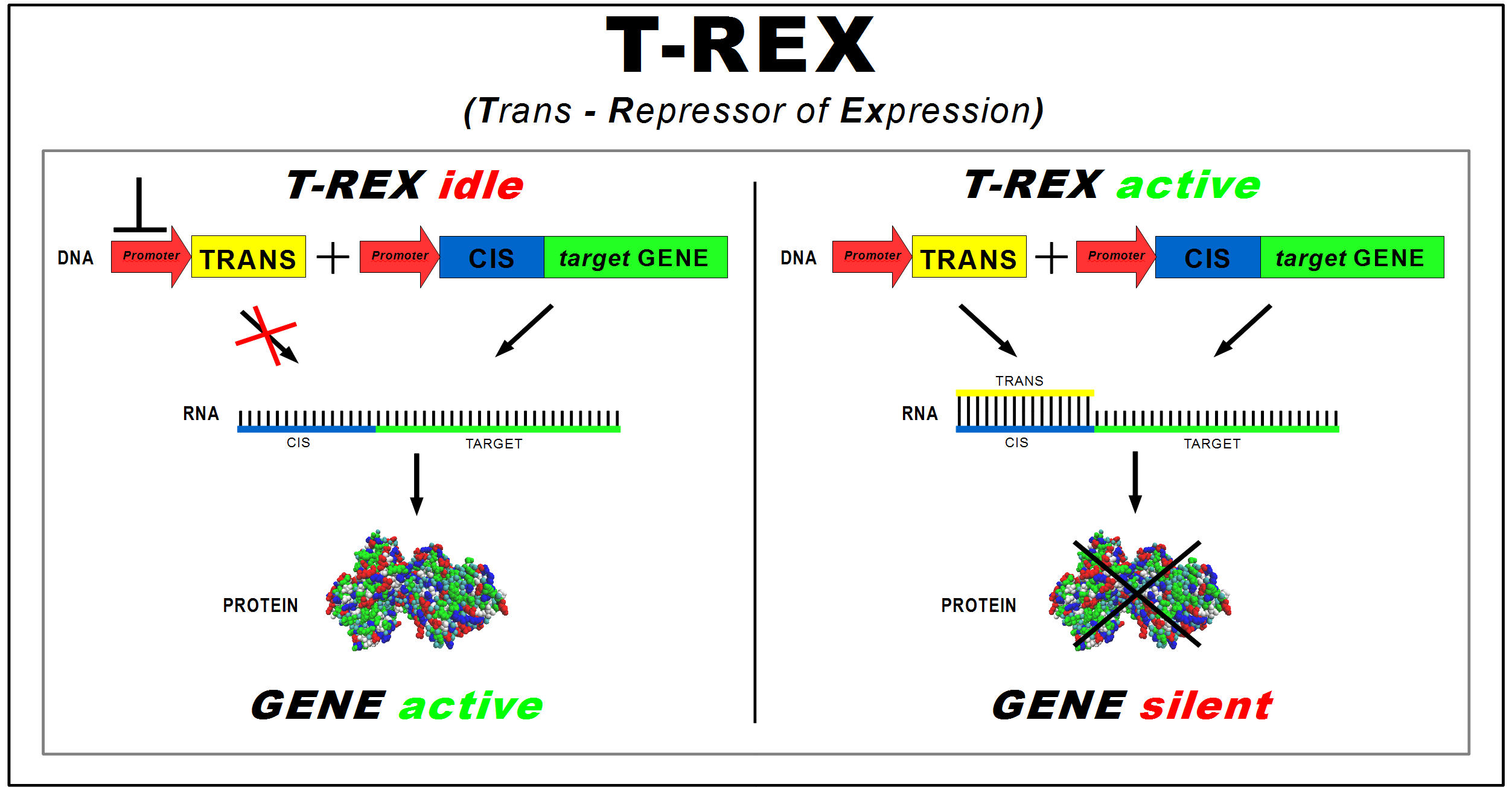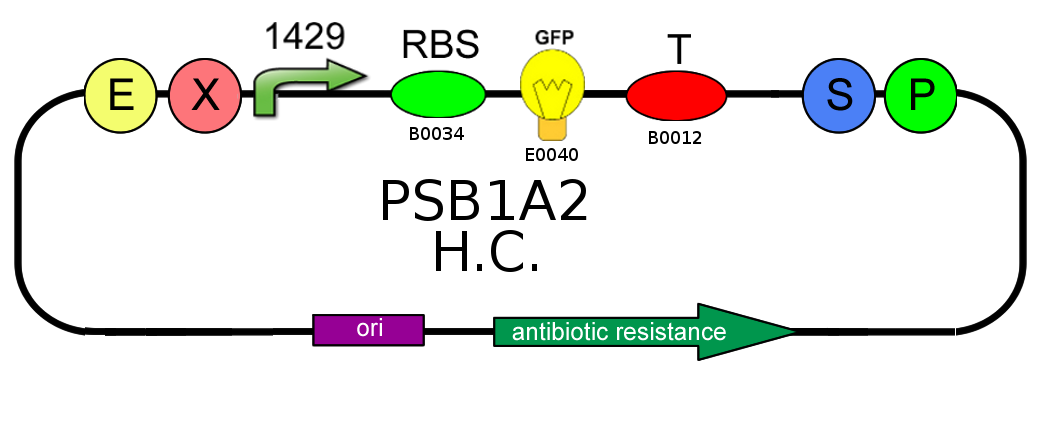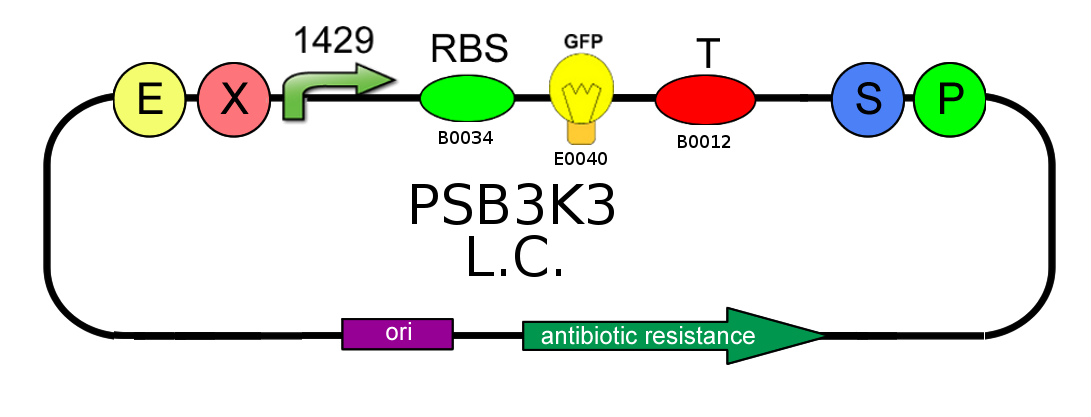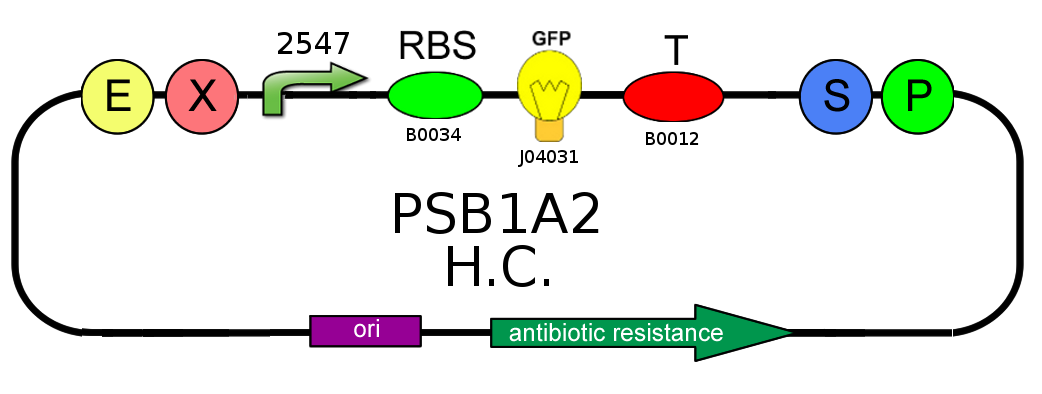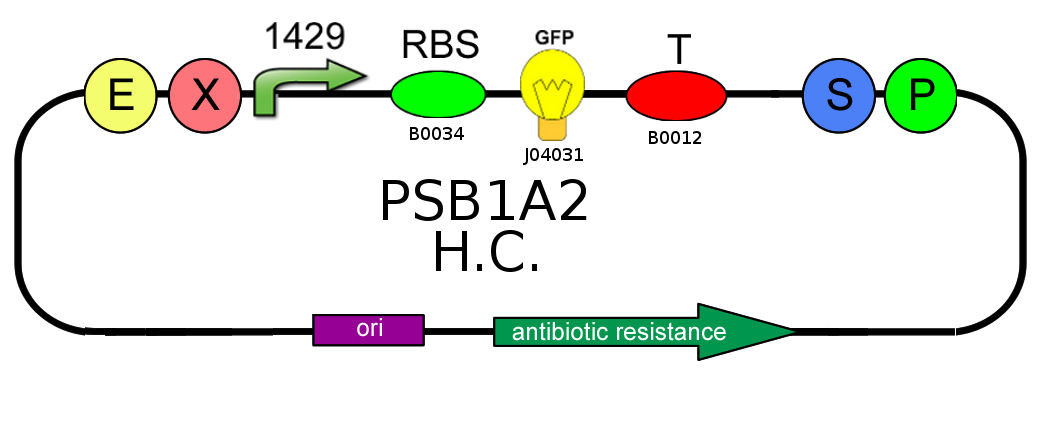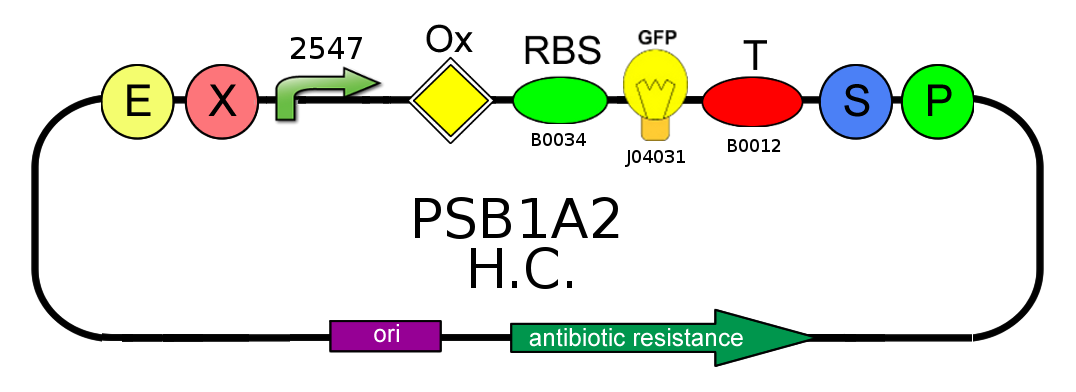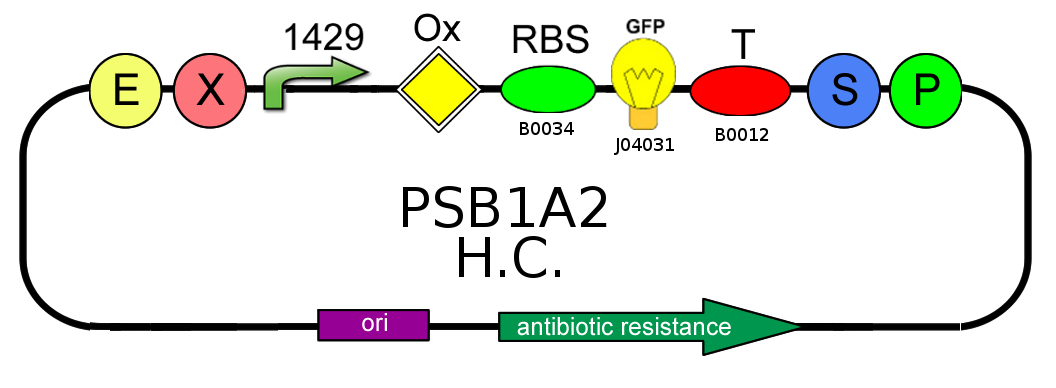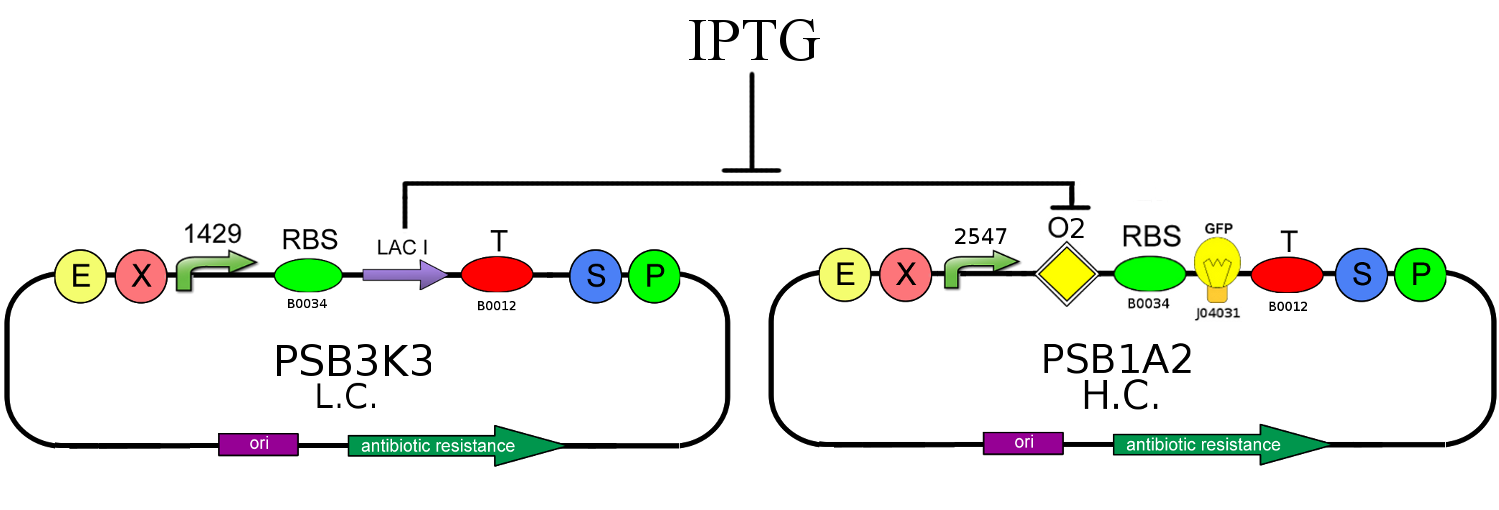Team:Bologna/Project
From 2009.igem.org
| Line 93: | Line 93: | ||
CIS-repressing and TRANS-repressor mRNAs bind together, preventing LacI translation and allowing GFP production. | CIS-repressing and TRANS-repressor mRNAs bind together, preventing LacI translation and allowing GFP production. | ||
<br> | <br> | ||
| + | Using some IPTG, the repression action of T-Rex become easily, because the concentration of free LacI in the cells is reduced. | ||
| + | <br><br> | ||
To prove T-Rex repression, GFP production level must be compared with the level produced by the OFF configuration of our T-Rex device, that is the same circuit in absence of TRANS-repressor: | To prove T-Rex repression, GFP production level must be compared with the level produced by the OFF configuration of our T-Rex device, that is the same circuit in absence of TRANS-repressor: | ||
<br><br> | <br><br> | ||
[[Image:OffCircuit_tag.png|center|900px]] | [[Image:OffCircuit_tag.png|center|900px]] | ||
<br><br> | <br><br> | ||
| - | In this second case, LacI is regularly translated and | + | In this second case, LacI is regularly translated and, binding with its O2 natural operator, it blocks GFP production. |
<br> | <br> | ||
We choose to use a low copy number plasmid and a weak promoter (J23118) for the CIS-repressing/LacI production, and a high copy number plasmid and a strong promoter (J23100) for the TRANS-repressing, to make reporter production's variations easily to be detected. | We choose to use a low copy number plasmid and a weak promoter (J23118) for the CIS-repressing/LacI production, and a high copy number plasmid and a strong promoter (J23100) for the TRANS-repressing, to make reporter production's variations easily to be detected. | ||
| + | <br> | ||
| + | <br> | ||
| + | <br> | ||
| + | <br> | ||
| + | Before realizing the whole T-Rex device, we decided to perform some preliminary tests, in order to characterize every single BioBrick involved in it. | ||
| + | <br> | ||
| + | <br> | ||
| + | <html> | ||
| + | <font face="Calibri" font size="5" color="#000000"><b><i>High</i> vs <i>Low to Medium</i> copy number plasmids </b> | ||
| + | <br><br> | ||
| + | <font face="Calibri" font size="4" color="#000000"> | ||
| + | </html> | ||
| + | * In order to characterize the difference between the high copy number pSB1A2 and the low to medium copy number pSB3K3, we analyzed production of I13504 (wild type GFP) under J23118 promoter (1429): | ||
| + | <br> | ||
| + | {|align="center" | ||
| + | |[[Image:1429GFP_openloop_hc.png|center|450 px]] | ||
| + | |[[Image:1429GFP_openloop_lc.png|center|450 px]] | ||
| + | |} | ||
| + | <center> | ||
| + | Results can be found in the [https://2009.igem.org/Team:Bologna/Characterization#Plasmid_copy_number_characterization wet-lab section] </center> | ||
| + | <br> | ||
| + | <br> | ||
| + | <html> | ||
| + | <font face="Calibri" font size="5" color="#000000"><b><i>Strong</i> vs <i>Weak</i> promoter </b> | ||
| + | <br><br> | ||
| + | <font face="Calibri" font size="4" color="#000000"> | ||
| + | </html> | ||
| + | * In order to characterize the different production of the high copy number pSB1A2 and the low to medium copy number pSB3K3, we analyzed I13504 (wild type GFP) under J23118 promoter (1429): | ||
| + | <br> | ||
| + | {|align="center" | ||
| + | |[[Image:1429GFP_openloop_hc.png|center|450 px]] | ||
| + | |[[Image:1429GFP_openloop_lc.png|center|450 px]] | ||
| + | |} | ||
| + | <center> | ||
| + | Results can be found in the [https://2009.igem.org/Team:Bologna/Characterization#Plasmid_copy_number_characterization wet-lab section] </center> | ||
| + | <br><br> | ||
| - | |||
| - | |||
| - | |||
| Line 109: | Line 144: | ||
| - | |||
| - | |||
| - | |||
| - | |||
| - | |||
| - | + | ||
| - | <br> | + | |
| - | + | ||
| - | + | <br><br><br><br> | |
| - | + | <br><br><br><br> | |
| - | + | <br><br><br><br> | |
| + | |||
| + | every part of the final device in order to obtain some information and values concerning the processes we were analyzing. All studies conducted by us can be found in detail in the [[Team:Bologna/Wetlab|Wetlab]] section. | ||
<br><br> | <br><br> | ||
| + | |||
| + | |||
| + | |||
* Then we analyzed the [https://2009.igem.org/Team:Bologna/Characterization#Promoter_characterization difference in strength of the two promoters] J23100 (2547) and J23118 (1429) studying the ratio of fluorescence. To do this we created these two circuits where the only different element was the promoter. Our goal was to find a ratio of fluorescence between the two circuits as close as possible to 1.78 (ratio between 2547 and 1429). | * Then we analyzed the [https://2009.igem.org/Team:Bologna/Characterization#Promoter_characterization difference in strength of the two promoters] J23100 (2547) and J23118 (1429) studying the ratio of fluorescence. To do this we created these two circuits where the only different element was the promoter. Our goal was to find a ratio of fluorescence between the two circuits as close as possible to 1.78 (ratio between 2547 and 1429). | ||
Revision as of 13:45, 21 October 2009
| HOME | TEAM | PROJECT | SOFTWARE | MODELING | WET LAB | PARTS | HUMAN PRACTICE | JUDGING CRITERIA |
|---|
(Trans-Repressor of Expression)
The project aims to implement a protein synthesis regulation system in Escherichia coli that acts at translational level, regardless of the target gene. This "general-purpose" device allows a faster control of protein expression.
The device was named T-Rex (Trans Repressor of Expression). It consists of two new BioBricks:
- CIS-repressing, to be assembled upstream of the target protein coding sequence; it contains a ribosomal binding site; (RBS)
- TRANS-repressor, to be placed under the control of a different promoter; it is complementary to the CIS-repressing, and contains a RBS cover in two versions of different length (4 and 7 nucleotides).
The longer version covers also 3 nucleotides of the Shine-Dalgarno sequence.
Transcription of the target gene produces a mRNA strand, starting with the Cis element, which is translated into proteins by ribosome. Trans’ promoter induction produces a transcript that binds with the Cis part. The RNA duplex prevents ribosome from binding to RBS, repressing protein synthesis. Thus, the TRANS-repressor amount regulates the gene mRNA translation rate.
The Parts
We choose to use 50bp non-coding sequences as CIS-repressing and TRANS-repressor complementary parts, and we developed a bioinformatic tool (BASER) to design them, in order to minimize unwanted interactions with genomic mRNA, reduce the probability of intra-molecular annealing and of partial/shifted hybridization.
| CIS-repressing | |||
| Prefix | non-coding TRANS target | RBS | Suffix |
| GAATTCGCGGCCGCTTCTAGAG | AACACAAACTATCACTTTAACAACACATTACATATACATTAAAATATTAC | AAAGAGGAGAAA | TACTAGTAGCGGCCGCTGCAG |
| TRANS-repressor (4) | |||
| Prefix | RBS cover | non-coding TRANS | Suffix |
| GAATTCGCGGCCGCTTCTAGAG | CTTT | GTAATATTTTAATGTATATGTAATGTGTTGTTAAAGTGATAGTTTGTGTT | TACTAGTAGCGGCCGCTGCAG |
| TRANS-repressor (7) | |||
| Prefix | RBS cover | non-coding TRANS | Suffix |
| GAATTCGCGGCCGCTTCTAGAG | CCTCTTT | GTAATATTTTAATGTATATGTAATGTGTTGTTAAAGTGATAGTTTGTGTT | TACTAGTAGCGGCCGCTGCAG |
The Genetic Circuits
In order to test and characterize our T-REX device, we developed the following genetic circuit:
The circuit above represents the ON configuration of our T-Rex device: TRANS-repressor is constitutively expressed and CIS-repressing is assembled upstream the LacI gene (BBa_C0012), while the reporter protein GFP (BBa_J04031) is assembled under the control of another promoter, regulated by LacI natural operator O2.
CIS-repressing and TRANS-repressor mRNAs bind together, preventing LacI translation and allowing GFP production.
Using some IPTG, the repression action of T-Rex become easily, because the concentration of free LacI in the cells is reduced.
To prove T-Rex repression, GFP production level must be compared with the level produced by the OFF configuration of our T-Rex device, that is the same circuit in absence of TRANS-repressor:
In this second case, LacI is regularly translated and, binding with its O2 natural operator, it blocks GFP production.
We choose to use a low copy number plasmid and a weak promoter (J23118) for the CIS-repressing/LacI production, and a high copy number plasmid and a strong promoter (J23100) for the TRANS-repressing, to make reporter production's variations easily to be detected.
Before realizing the whole T-Rex device, we decided to perform some preliminary tests, in order to characterize every single BioBrick involved in it.
High vs Low to Medium copy number plasmids
- In order to characterize the difference between the high copy number pSB1A2 and the low to medium copy number pSB3K3, we analyzed production of I13504 (wild type GFP) under J23118 promoter (1429):
Strong vs Weak promoter
- In order to characterize the different production of the high copy number pSB1A2 and the low to medium copy number pSB3K3, we analyzed I13504 (wild type GFP) under J23118 promoter (1429):
every part of the final device in order to obtain some information and values concerning the processes we were analyzing. All studies conducted by us can be found in detail in the Wetlab section.
- Then we analyzed the difference in strength of the two promoters J23100 (2547) and J23118 (1429) studying the ratio of fluorescence. To do this we created these two circuits where the only different element was the promoter. Our goal was to find a ratio of fluorescence between the two circuits as close as possible to 1.78 (ratio between 2547 and 1429).
- After that we needed to know if the presence of the Ox operator could influence or not the production of GFP. We tested two open loop GFP circuits for each promoter, one with the operator Ox and another without. We wanted to obtain the same GFP production in the two circuits built with the promoter 2547 and in the two circuits built with the 1429 one.
- We started to assemble circuits with the simultaneous presence of GFP and LACI to assess their operation and their interaction with each other. The first one is a closed-loop configuration where GFP expression is auto-regulated by the synthesis of LACI repressor protein; we used different IPTG induction concentration to evaluate the LACI repression strength. The second is an open-loop configuration lacking the operator site, so we can determine if there is repression in absence of Ox operator.
 "
"

